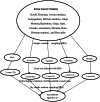High rate of attention deficit hyperactivity disorder among children 6 to 17 years old in Southwest Ethiopia findings from a community-based study
- PMID: 36890504
- PMCID: PMC9993367
- DOI: 10.1186/s12888-023-04636-9
High rate of attention deficit hyperactivity disorder among children 6 to 17 years old in Southwest Ethiopia findings from a community-based study
Abstract
Background: Attention-deficit/hyperactivity disorder is among the common neuropsychiatric disorders affecting children and adolescents. The disorder affects the life of children, their parents, and the community when left untreated. Although evidence indicated a high prevalence of attention-deficit/hyperactivity disorder in the developed world, there is limited evidence in developing countries, particularly, Ethiopia. Therefore, this study aimed to determine the prevalence and associated factors of attention deficit hyperactivity disorder among Ethiopian children aged 6 to 17 years.
Methods: A community-based cross-sectional study was conducted from August to September 2021 among children aged 6 to 17 years in Jimma town. A multistage sampling technique was applied to select 520 study participants. Data were collected by using the Vanderbilt Attention Deficit Hyperactivity Disorder- Parent Rating scale as a modified, semi-structured, and face-to-face interview. The association between independent variables and the outcome variable was investigated using bi-variable and multivariable logistic regression. The final model level of significance was set at a p-value of < 0.05.
Result: A total of 504 participants were involved in the study with a response rate of 96.9%. The overall prevalence of attention deficit hyperactivity disorder in this study was (9.9%, n = 50). Maternal complication during pregnancy (Adjusted odds ratio (AOR) = 3.56, 95% CI = 1.44-8.79, mothers illiteracy (AOR = 3.10, 95% CI = 1.24-7.79), attending primary school (AOR = 2.97, 95% CI = 1.32-6.73), history of head trauma (AOR = 3.20, 95% CI = 1.25-8.16), maternal alcohol use during pregnancy (AOR = 3.54, 95% CI = 1.26-10), bottle feeding during first six months (AOR = 2.87, 95% CI = 1.20-6.93) and child's age 6-11 years (AOR = 3.86, 95% CI = 1.77-8.43) were significantly associated with attention deficit hyperactivity disorder.
Conclusion: In this study, one in ten children and adolescents in Jimma town had attention deficit hyperactivity disorder. Therefore, the prevalence of attention deficit hyperactivity disorder was high. For this reason, there is a need to pay increased attention to control associated factors of attention deficit hyperactivity disorder and reduce its prevalence.
Keywords: Attention deficit hyperactivity disorder; Children; Jimma; Southwest Ethiopia.
© 2023. The Author(s).
Conflict of interest statement
The authors declare that they have no competing interest.
Figures
Similar articles
-
Prevalence and risk factors of attention deficit hyperactive disorder among children aged 6-17 years in arbaminch City, Gamo zone, Southern Ethiopia: a community-based cross-sectional study.BMC Psychiatry. 2025 Feb 25;25(1):175. doi: 10.1186/s12888-025-06625-6. BMC Psychiatry. 2025. PMID: 40001069 Free PMC article.
-
The pooled prevalence of attention-deficit/hyperactivity disorder among children and adolescents in Ethiopia: A systematic review and meta-analysis.PLoS One. 2024 Jul 18;19(7):e0307173. doi: 10.1371/journal.pone.0307173. eCollection 2024. PLoS One. 2024. PMID: 39024258 Free PMC article.
-
Prevalence and Associated Factors of Attention-Deficit Hyperactivity Disorder among Children Aged 6-17 Years in North Eastern Ethiopia.Ethiop J Health Sci. 2022 Mar;32(2):321-330. doi: 10.4314/ejhs.v32i2.13. Ethiop J Health Sci. 2022. PMID: 35693560 Free PMC article.
-
Co-morbidity of attention deficit hyperactivity disorder among children with seizure disorders at University of Gondar referral hospital Ethiopia (2016).Sci Rep. 2021 Aug 12;11(1):16368. doi: 10.1038/s41598-021-95751-8. Sci Rep. 2021. PMID: 34385491 Free PMC article.
-
Prevalence of attention deficit and hyperactive disorders in South Asian countries: A systematic review and meta-analysis of cross-sectional surveys from 1980 to 2023.Asian J Psychiatr. 2024 Apr;94:103970. doi: 10.1016/j.ajp.2024.103970. Epub 2024 Feb 12. Asian J Psychiatr. 2024. PMID: 38401384 No abstract available.
Cited by
-
Prevalence and risk factors of attention deficit hyperactive disorder among children aged 6-17 years in arbaminch City, Gamo zone, Southern Ethiopia: a community-based cross-sectional study.BMC Psychiatry. 2025 Feb 25;25(1):175. doi: 10.1186/s12888-025-06625-6. BMC Psychiatry. 2025. PMID: 40001069 Free PMC article.
-
Prevalence of attention-deficit hyperactivity disorder (ADHD): systematic review and meta-analysis.Eur Psychiatry. 2024 Oct 9;67(1):e68. doi: 10.1192/j.eurpsy.2024.1786. Eur Psychiatry. 2024. PMID: 39381949 Free PMC article.
-
The pooled prevalence of attention-deficit/hyperactivity disorder among children and adolescents in Ethiopia: A systematic review and meta-analysis.PLoS One. 2024 Jul 18;19(7):e0307173. doi: 10.1371/journal.pone.0307173. eCollection 2024. PLoS One. 2024. PMID: 39024258 Free PMC article.
-
The prevalence of attention-deficit hyperactivity disorder and its associated factors among children in Ethiopia, 2024: a systematic review and meta-analysis.Front Child Adolesc Psychiatry. 2024 Aug 23;3:1425841. doi: 10.3389/frcha.2024.1425841. eCollection 2024. Front Child Adolesc Psychiatry. 2024. PMID: 39844859 Free PMC article.
References
-
- Benjamin J, Sadock et al. S. Kaplan & Sadok’s comprehensive Text book of Psychiatry. 2017. 9141–9155 p.
-
- American Psychiatric Association, Diagnostic and Statistical Manual of Mental Disorders: DSM-5, American Psychiatric Association, Washington, DC., 2013. 2013. 2454 p.
-
- Moriyama TS, Cho M, Verin AJ, Fuentes RE, Polanczyk J, Verin GV. MIPH RE. IACAPAP Textbook of Child and Adolescent Mental Health SECTION D EXTERNALIZING DISORDERS. 2009. 6–7 p.
-
- Chiche S. DSM-5. In: Troubles mentaux et psychothérapies. 2016. p. 38.
Publication types
MeSH terms
LinkOut - more resources
Full Text Sources
Medical



